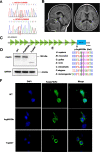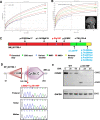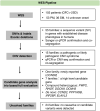Diagnostic yield and novel candidate genes for neurodevelopmental disorders by exome sequencing in an unselected cohort with microcephaly
- PMID: 37501076
- PMCID: PMC10373276
- DOI: 10.1186/s12864-023-09505-z
Diagnostic yield and novel candidate genes for neurodevelopmental disorders by exome sequencing in an unselected cohort with microcephaly
Abstract
Objectives: Microcephaly is caused by reduced brain volume and most usually associated with a variety of neurodevelopmental disorders (NDDs). To provide an overview of the diagnostic yield of whole exome sequencing (WES) and promote novel candidates in genetically unsolved families, we studied the clinical and genetic landscape of an unselected Chinese cohort of patients with microcephaly.
Methods: We performed WES in an unselected cohort of 103 NDDs patients with microcephaly as one of the features. Full evaluation of potential novel candidate genes was applied in genetically undiagnosed families. Functional validations of selected variants were conducted in cultured cells. To augment the discovery of novel candidates, we queried our genomic sequencing data repository for additional likely disease-causing variants in the identified candidate genes.
Results: In 65 families (63.1%), causative sequence variants (SVs) and clinically relevant copy number variants (CNVs) with a pathogenic or likely pathogenic (P/LP) level were identified. By incorporating coverage analysis to WES, a pathogenic or likely pathogenic CNV was detected in 15 families (16/103, 15.5%). In another eight families (8/103, 7.8%), we identified variants in newly reported gene (CCND2) and potential novel neurodevelopmental disorders /microcephaly candidate genes, which involved in cell cycle and division (PWP2, CCND2), CDC42/RAC signaling related actin cytoskeletal organization (DOCK9, RHOF), neurogenesis (ELAVL3, PPP1R9B, KCNH3) and transcription regulation (IRF2BP1). By looking into our data repository of 5066 families with NDDs, we identified additional two cases with variants in DOCK9 and PPP1R9B, respectively.
Conclusion: Our results expand the morbid genome of monogenic neurodevelopmental disorders and support the adoption of WES as a first-tier test for individuals with microcephaly.
Keywords: Microcephaly; Neurodevelopmental disorders; Novel candidates; Whole exome sequencing.
© 2023. The Author(s).
Conflict of interest statement
The authors declare no competing interests.
Figures





Similar articles
-
Deciphering the molecular landscape of microcephaly in 87 Indian families by exome sequencing.Eur J Med Genet. 2022 Jun;65(6):104520. doi: 10.1016/j.ejmg.2022.104520. Epub 2022 May 12. Eur J Med Genet. 2022. PMID: 35568357
-
Incorporation of exome-based CNV analysis makes trio-WES a more powerful tool for clinical diagnosis in neurodevelopmental disorders: A retrospective study.Hum Mutat. 2021 Aug;42(8):990-1004. doi: 10.1002/humu.24222. Epub 2021 May 31. Hum Mutat. 2021. PMID: 34015165
-
Clinical Characterization and Underlying Genetic Findings in Brazilian Patients with Syndromic Microcephaly Associated with Neurodevelopmental Disorders.Mol Neurobiol. 2024 Aug;61(8):5230-5247. doi: 10.1007/s12035-023-03894-8. Epub 2024 Jan 5. Mol Neurobiol. 2024. PMID: 38180615
-
Proband only exome sequencing in 403 Indian children with neurodevelopmental disorders: Diagnostic yield, utility and challenges in a resource-limited setting.Eur J Med Genet. 2023 May;66(5):104730. doi: 10.1016/j.ejmg.2023.104730. Epub 2023 Feb 15. Eur J Med Genet. 2023. PMID: 36801247 Review.
-
Meta-analysis and multidisciplinary consensus statement: exome sequencing is a first-tier clinical diagnostic test for individuals with neurodevelopmental disorders.Genet Med. 2019 Nov;21(11):2413-2421. doi: 10.1038/s41436-019-0554-6. Epub 2019 Jun 11. Genet Med. 2019. PMID: 31182824 Free PMC article.
Cited by
-
tubg1 Somatic Mutants Show Tubulinopathy-Associated Neurodevelopmental Phenotypes in a Zebrafish Model.Mol Neurobiol. 2025 Mar;62(3):3024-3039. doi: 10.1007/s12035-024-04448-2. Epub 2024 Aug 31. Mol Neurobiol. 2025. PMID: 39215931
-
Genomic Balancing Act: deciphering DNA rearrangements in the complex chromosomal aberration involving 5p15.2, 2q31.1, and 18q21.32.Eur J Hum Genet. 2025 Mar;33(2):231-238. doi: 10.1038/s41431-024-01680-1. Epub 2024 Sep 10. Eur J Hum Genet. 2025. PMID: 39256534 Free PMC article.
References
MeSH terms
Grants and funding
LinkOut - more resources
Full Text Sources
Research Materials
Miscellaneous

